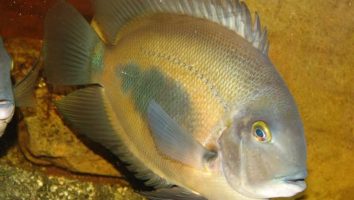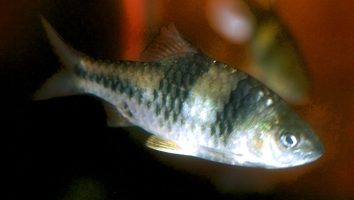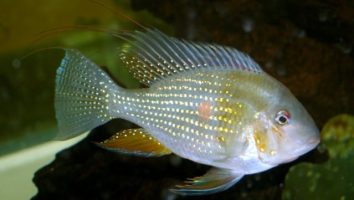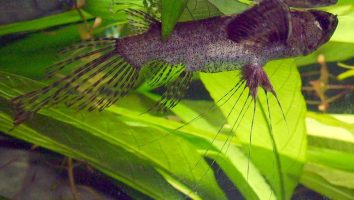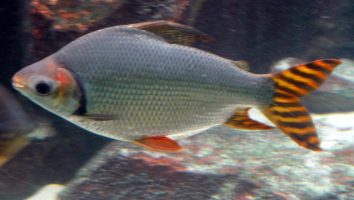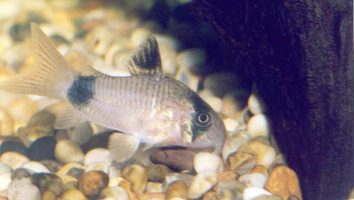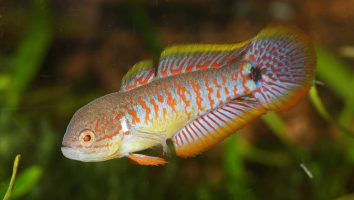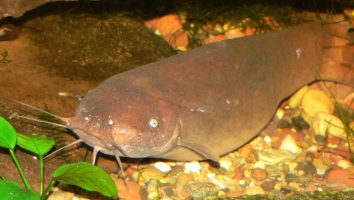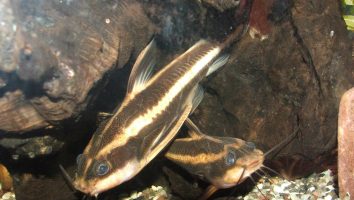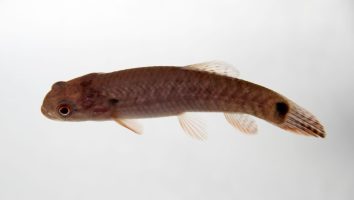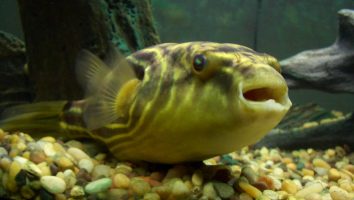The bumblebee goby is a beautiful and unique freshwater fish that is perfect for any aquarium.
This species is relatively easy to care for and is very peaceful, making it a great addition to any community tank.
They are also very active and interesting to watch, as they are constantly on the move looking for food.
If you’re thinking about getting a bumblebee goby, you’ll need to know how to care for them properly. This guide will teach you everything you need to know!
Table of contents
Species overview
The Bumblebee Goby (Brachygobius doriae) is a small fish that is found in brackish and freshwater habitats in Southeast Asia.
They get their name from their unique coloration which is a yellowish-brown body with black stripes that resemble a bumblebee.
In the wild, these fish are found in areas with very little water flow and a lot of vegetation. This is because they are primarily surface-dwelling fish that like to hide among the plants.
Bumblebee gobies are very peaceful fish that do well in community tanks. They are also one of the few species of goby that can be kept in a freshwater aquarium.
One of the most unique things about this fish is that the males carry the eggs in their mouths until they hatch. The female will then care for the fry until they are big enough to fend for themselves.
Appearance
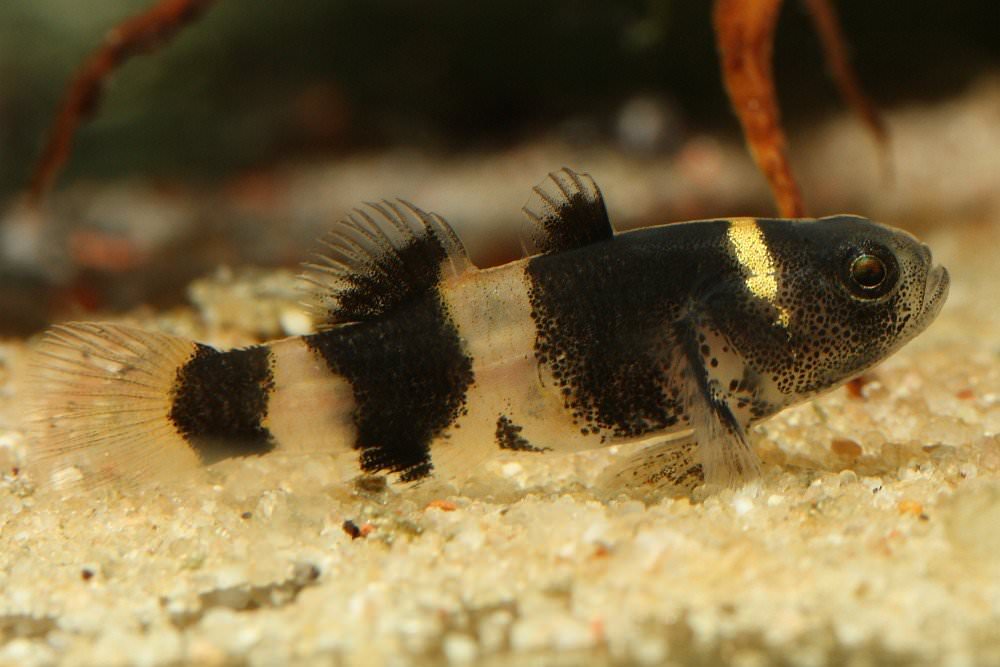
Bumblebee gobies are one of the most unique looking freshwater fish in the hobby. As you can probably guess from their name, these fish are black and yellow. This coloration is what gives them their “bumblebee” appearance.
The body of the bumblebee goby is long and slender. They have a laterally compressed body which gives them a unique look in the aquarium.
These fish have a very long dorsal fin that starts at the back of their head and extends almost to their caudal peduncle. This fin has a very pointed look to it.
Their caudal fin is forked and their anal fin is rather short. Both of these fins are black with a yellow margin.
The pectoral fins of the bumblebee goby are clear and rather small. These fins are used for steering and braking more than anything else.
The head of the bumblebee goby is rather large and their mouth is located at the bottom. This gives them a very “grumpy” appearance that a lot of people find quite cute.
Lifespan
The average bumblebee goby lifespan is around 3 years. This can obviously be impacted by a number of different factors but, in general, these fish don’t live a particularly long time.
One thing that does impact their lifespan is whether or not they reproduce. The process of reproducing takes a lot out of these fish and can shorten their lifespan quite a bit.
The level of care they receive is also a big factor. If they’re in a well-maintained tank with good water quality then they’ll usually live on the higher end of the lifespan range.
Size
Bumblebee gobies only grow to be about 2 inches in length.
Tank
Tank Size
The minimum tank size for a bumblebee goby is 10 gallons. If you’re looking for a nano fish that can fit in a small tank, this is a good option.
While you can keep more than one bumblebee goby in the same tank, we recommend a 20 gallon tank if you want to keep a school of these fish. This will give them enough space to swim around and set up their own little territories.
Water Parameters
The bumblebee goby is a brackish water fish, which means that it needs a mix of both fresh and salt water to thrive. The ideal ratio is about 1 part salt to every 3 parts fresh water.
You can use a hydrometer to measure the salinity of the water. Most pet stores will also have a salinity tester that you can use.
The other water parameters for bumblebee gobies are pretty standard for a freshwater fish. They prefer slightly acidic water with a neutral pH. The temperature can range from 72 to 82 degrees Fahrenheit.
- Water temperature: 72 to 82 degrees Fahrenheit
- pH levels: 6.5 to 7.5
- Water hardness: 2 to 12 dGH
- Alkalinity Levels: 4-8 dKH
What To Put In Their Tank
Bumblebee gobies are a species of fish that come from brackish water habitats. This means that they can live in either freshwater or saltwater, but they do best in water that’s somewhere in between.
When it comes to setting up their tank, you have a few different options. You can either go with a freshwater setup or a brackish water setup.
If you decide to go with a freshwater setup then you’ll need to include a way to raise the water’s salinity. This can be done with a saltwater aquarium kit or by using marine salt.
If you go with a brackish water setup then you won’t need to do anything special. Just make sure the water in their tank is at the correct salinity level.
As for the inside of their tank, these fish don’t have any special requirements. They’re not picky eaters and they’re not fussy when it comes to decorations.
You can include plants, rocks, and driftwood if you want. Just make sure that everything is secure and won’t fall over and hurt your fish.
The substrate you choose is also up to you. Sand or gravel will both work fine.
Common Diseases
The bumblebee goby is a hardy fish that is resistant to most diseases. However, there are a few that you should be aware of.
The most common disease that these fish experience is ich. This is a parasites that affects freshwater fish and can be quite serious if left untreated.
The most obvious symptom of ich is the presence of white spots on the body of your fish. If you notice this, it’s important to act quickly and begin treatment.
Other potential diseases include infections, bacteria, and parasites. These are all relatively uncommon but can still affect your bumblebee goby if the conditions are right.
As with any other fish, the best way to keep your bumblebee goby healthy is to maintain a clean and stable habitat. This will go a long way in preventing disease and keeping your fish happy and healthy.
Behavior & Temperament
The Bumblebee goby is a unique little fish that is known for its unusual behavior. These fish are not the most social creatures and prefer to live alone or in pairs. They are also known to be a bit aggressive towards other fish, especially if they feel threatened.
The Bumblebee goby is a nocturnal fish, which means it is most active at night. During the day, it will usually hide in its burrow or among the rocks. When night falls, it will come out to feed.
These fish are not known for being very active. They tend to stay in one place most of the time. However, they are known to be curious creatures and will sometimes explore their surroundings.
The Bumblebee goby is a peaceful fish, but it can be a bit aggressive towards other fish. It is also known to be a bit shy and reclusive.
Tank Mates
In the wild, bumblebee gobies are found in brackish water. This is a mix of salt and freshwater that’s not as harsh as full-blown saltwater.
Because of this, they can be acclimated to a wide range of water conditions. This makes finding tank mates for bumblebee gobies a breeze!
Here are some compatible species to get you started:
- Mollies
- Guppies
- Platies
- Swordtails
- Cherry Barbs
- Neon Tetras
- Ghost Shrimp
- Yellowtail Blue Damselfish
- Royal Gramma
- Ocellaris Clownfish
Breeding
Bumblebee gobies are one of the easier species of fish to breed in captivity. They don’t have too many specific requirements and will often breed without much intervention from the aquarist.
The first step is to set up a breeding tank. It should be at least 10 gallons and filled with soft, sandy substrate. The water should be clean and well-filtered with a moderate flow.
The temperature can be kept at the lower end of the goby’s range, around 72 degrees Fahrenheit.
Add some live plants and a few hiding places for the adults. Breeding caves or lengths of PVC pipe work well.
When ready, add a pair of bumblebee gobies to the tank. These fish are not too picky when it comes to their mates. A male and female of any size will do.
The female will lay her eggs in a cave or hiding place. The male will then fertilize them. After that, he’ll stay close by to protect them.
The eggs will hatch in about a week. At that point, you can start feeding the fry baby brine shrimp or other small live foods. Keep an eye on the water quality and do regular water changes to ensure the fry stay healthy.
Conclusion
The bumblebee goby is a great addition to any aquarium. They’re relatively easy to care for, and their unique coloration and patterning add some visual interest to your tank.
We do recommend that you keep them with other peaceful fish, as their small size can make them a target for aggression from larger fish.
Overall, we think the bumblebee goby is a great choice for any fishkeeper, and we hope you’ll consider them for your next aquarium!

